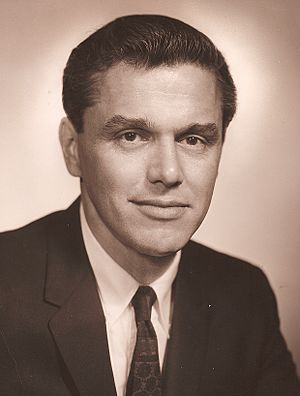Robert K. Crane facts for kids
Quick facts for kids
Robert K. Crane
|
|
|---|---|
 |
|
| Born | December 20, 1919 |
| Died | October 31, 2010 (aged 90) |
| Alma mater | Washington College |
| Known for | Cotransport |
| Awards | American Gastroenterological Association Distinguished Achievement Award (1969) Dr. Harold Lamport Award, New York Academy of Sciences (1977) |
| Scientific career | |
| Fields | Biochemistry |
| Institutions | Washington University in St. Louis Chicago Medical School Rutgers Medical School of the University of Medicine and Dentistry of New Jersey |
Robert Kellogg Crane (December 20, 1919 – October 31, 2010) was an American biochemist best known for his discovery of sodium–glucose cotransport.
Contents
Biography
Crane was born on December 20, 1919 in Palmyra, New Jersey, to Wilbur Fiske Crane, Jr. architect and engineer, and Mary Elizabeth McHale Crane. He is the grandson of Stephen Crane's brother Wilbur.
He received a B.S. from Washington College in 1942. After serving in the Navy during World War II, Crane studied in biochemistry with Eric Ball at Harvard from 1946 to 1949, then spent a year with Fritz Lipmann at Harvard Medical School, and received a Ph.D. in Medical Sciences in 1950. He then joined Carl Cori's Department of Biological Chemistry at Washington University School of Medicine in St. Louis, where he began his long interest in glucose metabolism and worked until 1962. After that, he was professor and chairman of the department of Biochemistry at the Chicago Medical School until 1966 and then became professor and chairman of the department of Physiology and Biophysics at Rutgers Medical School (now known as Robert Wood Johnson Medical School) of the University of Medicine and Dentistry of New Jersey until 1986. He received a Sc.D. from Washington College in 1982.
Discovery of cotransport
In the 1950s, Crane played a central role in establishing that glucose transport into the cell was the first step in glucose metabolism and its control. He demonstrated that neither the phosphorylation-dephosphorylation mechanism nor other covalent reactions accounted for glucose transport in the intestine.
In August 1960, in Prague, Crane presented for the first time his discovery of the sodium-glucose cotransport as the mechanism for intestinal glucose absorption. Cotransport was the first ever proposal of flux coupling in biology and was the most important event concerning carbohydrate absorption in the 20th century.
Application in oral rehydration therapy
Crane's discovery of cotransport led directly to the development of oral rehydration therapy. This treatment counterbalances the loss of water and electrolytes caused by cholera via a glucose containing salt solution that accelerates water and electrolyte absorption. This is possible because cholera does not interfere with sodium-glucose cotransport.
Oral rehydration therapy saves the lives of millions of cholera patients in underdeveloped countries since the 1980s. In 1978, The Lancet wrote: "the discovery that sodium transport and glucose transport are coupled in the small intestine, so that glucose accelerates absorption of solute and water, was potentially the most important medical advance this century."
Awards and honors
- Distinguished Achievement Award, American Gastroenterological Association, 1969.
- Sir Arthur Hurst Memorial Lectureship, British Society of Gastroenterology, 1969.
- Gastrointestinal Section Lectureship, American Physiological Society, 1971.
- Dr. Harold Lamport Award, New York Academy of Sciences, 1977.
- Doctor of Science (honoris causa), Washington College, 1982.
- Honorary Chairman, International Symposium on the 25th Anniversary of the Gradient Hypothesis, Aussois, France, 18, 19 and 20 September 1985.
See also
 In Spanish: Robert K. Crane para niños
In Spanish: Robert K. Crane para niños
- Cotransport
- Cotransporter
- Sodium-glucose transport proteins
- Glucose transporter
- Oral rehydration therapy


